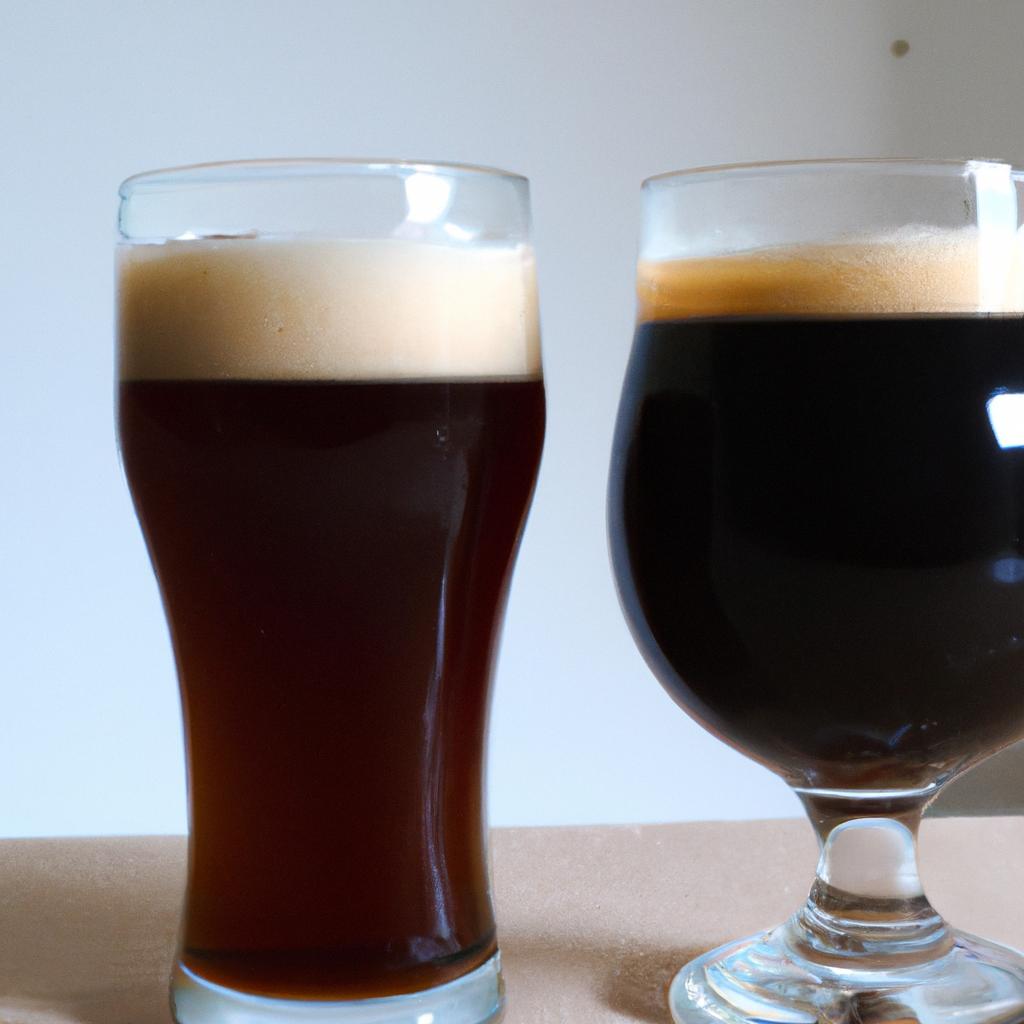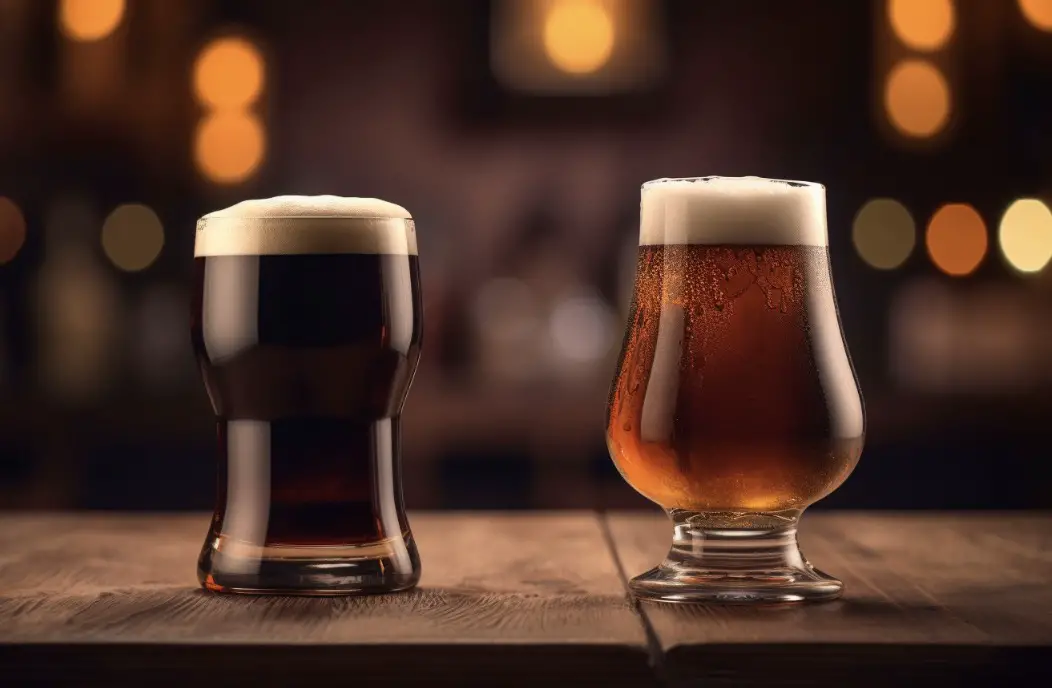As a brewer with years of experience, I’ve had the opportunity to dive deep into the world of beer, exploring various styles of brewing and tasting the results. Two styles that often spark debate and curiosity are brown ales and stouts. While both are dark, rich, and flavorful, they have distinct differences that set them apart from each other.
So, what is the difference between a brown ale and a stout? Brown ales are characterized by their deep amber to brown color, mild to moderate bitterness, and malt-forward flavors with notes of caramel, chocolate, or nuttiness.
Stouts, on the other hand, are darker in color, often nearly black, with pronounced roasted flavors, and a smooth, creamy mouthfeel.
In this blog post, we will delve into the world of brown ales and stouts, discussing their histories, flavors, and brewing processes.
A Brief History of Brown Ales
Brown ales can be traced back to the early days of brewing, with roots in England. In fact, the term “ale” originally referred to any beer that was not a lager. Over time, the brown ale style evolved, with regional variations such as the English brown ale, American brown ale, and the Belgian oud bruin.

English Brown Ale
English brown ales are malt-forward beers that showcase a wide range of flavors from caramel and toffee to chocolate and nuttiness. They are often divided into two subcategories: Northern English brown ale and Southern English brown ale. Northern English brown ales are typically drier and more bitter, while Southern English brown ales are sweeter and richer. Some classic examples include Newcastle Brown Ale and Samuel Smith’s Nut Brown Ale.
American Brown Ale
American brown ales are a modern take on the English brown ale, with a stronger hop presence and slightly higher alcohol content. They still maintain the malt-forward profile but often have additional flavors from the use of American hops, which can impart citrusy, piney, or floral notes. Notable examples include Brooklyn Brown Ale and Sierra Nevada Tumbler.

A Brief History of Stouts
Stouts are a subcategory of porters, which were popular among London’s working class in the 18th century. The name “stout” was originally used to describe a strong or robust porter. Over time, the stout style evolved and diversified, resulting in various subcategories such as dry stout, sweet stout, and imperial stout.
Dry Stout
Dry stouts, also known as Irish stouts, are characterized by their dark, almost black color and roasted flavors, often with coffee or chocolate notes. They have a relatively low alcohol content and are known for their smooth, creamy mouthfeel, often achieved through the use of nitrogen gas when serving. The most famous example is Guinness.
Sweet Stout
Sweet stouts, also known as milk stouts or cream stouts, are brewed with lactose, a sugar derived from milk that is not fermentable by yeast, which results in a sweeter, creamier beer. They often have flavors of chocolate, caramel, or coffee and a rich, full-bodied mouthfeel. Examples include Left Hand Milk Stout and Samuel Adams Cream Stout.
The Brewing Process: Brown Ale vs Stout
While both brown ales and stouts share some similarities in their brewing processes, there are key differences in the ingredients and techniques used to create their unique flavors and characteristics.
Malt Selection
The type of malt used in brewing greatly influences the final color, flavor, and aroma of the beer. Brown ales typically employ a combination of pale malt, crystal malt, and small amounts of darker malts such as chocolate malt or black malt. This combination results in the deep amber to brown color and the caramel, chocolate, or nutty flavors often found in brown ales.
Stouts, on the other hand, rely heavily on roasted barley or heavily roasted malts to achieve their dark color and roasted flavors. These malts can impart flavors of coffee, chocolate, or even a slight smokiness.
Hops and Bitterness
In general, brown ales have a mild to moderate bitterness that balances the malt sweetness. English brown ales tend to use traditional English hop varieties, which can contribute earthy, floral, or spicy notes. American brown ales often use American hop varieties, adding citrusy or piney flavors.
Stouts, particularly dry stouts, can have a more pronounced bitterness, which comes from both the roasted malts and the hops used. English or European hop varieties are commonly used in stouts, providing a more subtle hop character that allows the roasted flavors to shine.
Yeast and Fermentation
Both brown ales and stouts are typically brewed using ale yeast, which ferments at warmer temperatures and contributes fruity esters or other flavor compounds. However, the specific yeast strain and fermentation conditions can vary between the two styles, impacting the final beer’s flavor profile.
Comparing Appearance and Aroma
Brown ales and stouts can be easily distinguished by their appearance. Brown ales range in color from deep amber to brown, with a moderate to large off-white to tan head. Stouts are darker, often nearly black, with a thick, creamy tan to brown head.
Aromas also differ between the two styles. Brown ales often exhibit notes of caramel, chocolate, or nuttiness, with subtle hop character. Stouts, on the other hand, have pronounced roasted aromas, often with coffee or chocolate notes, and a more subdued hop presence.
Conclusion – Brown Ale vs Stout
In conclusion, the main differences between brown ale and stout can be summarized as follows:
1. Brown ales have a deep amber to brown color, while stouts are darker, often nearly black.
2. Brown ales are malt-forward with flavors of caramel, chocolate, or nuttiness, while stouts have pronounced roasted flavors.
3. Brown ales have mild to moderate bitterness, while stouts can have more pronounced bitterness.
4. Brown ales often use a combination of pale malt, crystal malt, and darker malts, while stouts rely heavily on roasted barley or heavily roasted malts.
5. English brown ales use traditional English hop varieties, while American brown ales often use American hop varieties.
6. Stouts typically use English or European hop varieties for a more subtle hop character.
7. Brown ales have a moderate to large off-white to tan head, while stouts have a thick, creamy tan to brown head.
8. Brown ale aromas include caramel, chocolate, or nuttiness, while stout aromas have pronounced roasted notes, often with coffee or chocolate.
9. Both brown ales and stouts are brewed using ale yeast, but the specific yeast strain and fermentation conditions can impact the final flavor profile.
10. Regional variations of brown ales include English brown ale, American brown ale, and Belgian oud bruin, while stouts have subcategories such as dry stout, sweet stout, and imperial stout.
By understanding the differences between these two classic beer styles, you can better appreciate the unique characteristics and flavors that each has to offer. Whether you’re a brewer looking for inspiration or a beer enthusiast eager to expand your palate, exploring the world of brown ales and stouts is a rewarding journey.
FAQs
Is stout and ale the same thing?
No, stout and ale are not the same thing. While both are types of beer, stout is typically darker, richer, and has a higher alcohol content than ale. Additionally, stout is made with roasted barley, which gives it its distinct flavor, while ale is made with a variety of grains.
What is the difference between ale and stout?
Ale is a type of beer made with top-fermenting yeast and is typically lighter in color and body than stout, which is made with roasted malt and has a darker color and fuller body. Stouts also often have a distinct coffee or chocolate flavor.
What is the difference between an ale and a brown ale?
An ale is a type of beer that is made with a warm fermentation process using a type of yeast that ferments at the top of the brewing vessel. A brown ale is a specific type of ale that is darker in color and has a slightly sweeter, nuttier flavor profile due to the use of roasted malts.
What makes an ale a stout?
Stouts are a type of ale that are typically darker and stronger than other ales, with a roasted malt flavor and a creamy, full-bodied texture. The use of roasted barley in the brewing process is what gives stouts their characteristic dark color and rich, complex flavor profile.
What is a brown ale vs stout vs porter?
Brown ale, stout, and porter are all types of dark beer. Brown ale is a lighter-bodied, sweet and nutty beer with a low bitterness. Stout is a full-bodied, rich and creamy beer with a roasted flavor and high bitterness. Porter is a medium-bodied, slightly sweet beer with a roasted flavor and low bitterness. The main difference between them is the level of roastiness and bitterness.
Is Guinness a stout or porter?
Guinness is a stout.




